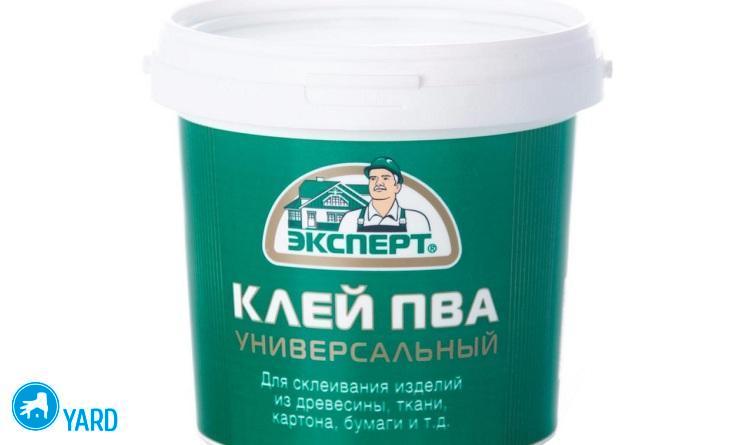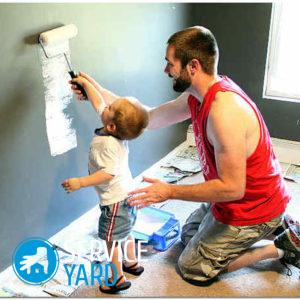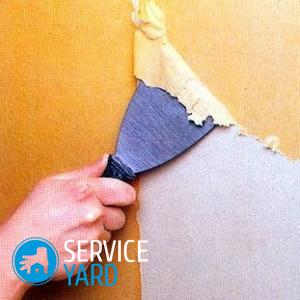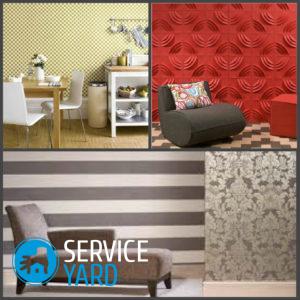PVA glue for wallpaper
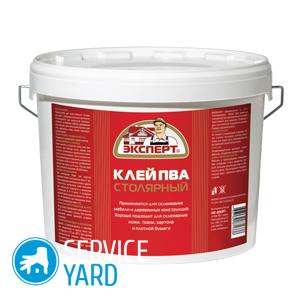
Now in construction stores there are goods for any type of repair, for any wallet. If before we had a meager selection of paper wallpapers, now we offer many options for wall decoration: vinyl, non-woven, glass and others. At the same time, paper ones continue to firmly hold their positions. For each type of wallpaper in the store you will be offered your own type of paste, which is ideal. Depending on the manufacturer, quality and price will be different. But during a minor in-line repair, many people use PVA glue for wallpaper. Is this right? Or maybe you can glue all the wallpaper on it? In this article you will find answers to these questions and learn all the nuances of the correct use of such a familiar glue - PVA.
to contents ↑PVA and wallpaper
In general, the modern master, planning to glue the walls, will buy wallpaper glue. It is unlikely that anyone would think of looking for a PVA bucket for this purpose.
But in order to glue the joints, a corner that peeled off over time, an accidentally damaged section of the wall, PVA glue is often used. It is perfect for this type of decoration, it holds well, is inexpensive, and is always at hand (especially when there are children in the house). After all, you see, it happens that the repair was far from yesterday, the remnants of wallpaper paste went into oblivion, can we really run for a whole pack of new for a couple of patches? Most likely, no, we will look for improvised means. It is such a lifesaver that will prove to be PVA.
to contents ↑Adhesive Features
Let's see what its advantages are and is it possible to glue the wallpaper with PVA glue?
PVA glue is an emulsion of polyvinyl acetate in water containing a plasticizer and some additives. The composition is a water-based dispersion substance, so the surfaces stick together when the water evaporates.
Advantages:
- The composition quickly and firmly glues the surface.
- Non toxic
- It does not have a pronounced unpleasant odor.
Disadvantages:
- Wallpaper, smeared with PVA, will stick, of course, to “excellent”, but at the same time the treated area will become stiff, and may turn yellow over time.
- If the surfaces to be glued are porous and rough, the glue will not adhere well.
- A significant disadvantage of using this glue in this area is that wallpaper will then have to be literally gnawed off the wall with teeth.
Important! Most of us have not been repairing for centuries, and at least once a decade we change the design of the walls of the room. Therefore, in order not to complicate your work in the future and then not to curse those who came up with PVA and their mental abilities, do not get carried away with this glue in continuous repair.
Based on the foregoing, PVA glue is not used in wallpapering on a large scale. And what will happen if you still try?
to contents ↑The consequences of sticking all the wallpapers with PVA glue:
- The amount of PVA that will be needed for the whole room will cost more than wallpaper paste. So you can’t call this option budget.
- This glue is thick and less slippery than wallpaper. And this is bad and uncomfortable. To stick the strip correctly, evenly, and to be able to fix something in the process, the composition should be slippery and not very quickly set. If you spread a strip of polyvinyl acetate, then aligning it or removing it back from the wall will be problematic.
- If you used this adhesive when gluing the walls, then during the subsequent repair you will have to scrape the old coating with a spatula, damaging the surface of the wall. It is especially tragic if the walls are made of drywall.
Important! Soak old wallpaper will not succeed, as do not try. This number will only pass if a wallpaper paste has been used.
- Wallpaper glued with PVA becomes hard and may turn yellow, especially those made on a paper basis.
- This adhesive is not suitable for porous and rough surfaces. Long cellulose fibers prevent the composition from smoothly filling all irregularities and pores.
- If you glue the walls with this type of glue, then you can hardly apply it with a perfectly uniform layer. Where the thickness is greater, bubbles will form, which are difficult to get rid of, since air remains in such a film. She, drying up, becomes only stronger. Wallpaper glue has no such effect.
Important! So, we see that when using PVA as wallpaper glue, there are much more minuses than pluses. Is it possible to glue wallpaper on PVA glue? Experts strongly recommend that you do not use this type of glue in this quality.
And if you still really want to? Well, if there are no options other than this adhesive, then you should know the rules for its use.
to contents ↑How to glue wallpaper with PVA glue?
Dissolve glue with water in proportion: 3 parts water to 1 part PVA. It can also be added in small quantities to wallpaper paste for non-woven wallpaper (150 ml / l), or used for priming walls.
Important! You can meet wallpaper glue “PVA Strength” or “PVA for wallpaper” on the shelves of construction stores. Keep in mind, this is a regular wallpaper glue with just a little PVA added.
Nevertheless, we strongly recommend using this white adhesive without fanaticism. If there is no residue of wallpaper glue on hand, you can use the usual PVA, but only pointwise, for gluing small areas.
to contents ↑General recommendations for wallpapering:
- Before gluing the walls, carefully level the surface with putty or drywall. For silk-screen printing, the walls should be perfectly flat and smooth. If the walls are painted, prime them.
- Before buying wall decoration, carefully calculate the right amount of consumables. Wallpaper take from one party (so that the shade does not differ) and with a small margin. If they are with a pattern that needs to be combined, take a larger margin. Choose wallpaper glue for your type of wallpaper.
Important! Remember that PVA glue for wallpaper is not the best option.
- For different rooms, its own type of decoration is recommended: for the nursery - eco-friendly paper, for the kitchen - washable, for the hallway - wear-resistant, vinyl. And for the hall you can have any - at least textile, at least non-woven, at least silk-screen printing.
- Free the room from furniture, remove switches, sockets. Start work from the window. For the first strip, mark with the level and plumb line.
- During sticking, close windows, doors, turn off heaters and fans, avoid drafts and sudden changes in temperature.
- Apply glue according to the type of material. Vinyl and paper products need to be spread with paste, and non-woven and textile products do not need this, the adhesive is applied only to the wall.
- When spreading strips, carefully coat the edges and corners.
- When gluing the strip, try not to stretch it. Align the surface from the center to the edges.
- Thick wallpaper needs to be glued butt. To ensure that the edges do not diverge, it is recommended to glue special paper tapes under the joints.
- After gluing the strip, it is convenient to cut off excess with a wide spatula and a clerical knife.
- In the corners, be sure to cut one strip, and the second - glue overlap, then when dried, they will not separate.
- Remove excess adhesive from the front immediately with a clean, soft cloth.
to contents ↑Important! When gluing textile wallpapers, try to ensure that the paste does not fall on the front side at all.
Stock footage
With a question, is it possible to glue wallpaper on PVA glue, we figured it out. Many will be stopped by the consequences of using this glue on large sections of the wall. Well, gluing a small corner of this tool is very suitable. If you still have remnants of wallpaper glue or your neighbors are repairing at full strength, then it is better to give preference to wallpaper paste, even for repairing small sections of the wall. So you can avoid untidy yellow spots on paper.



